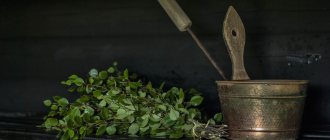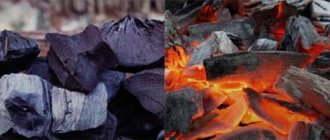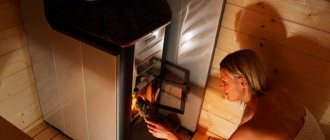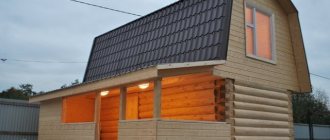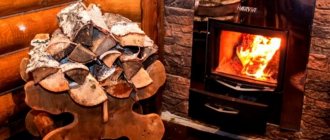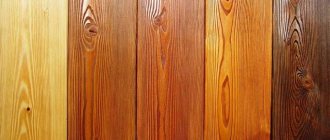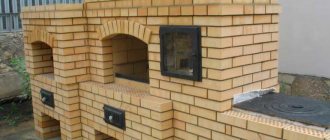Date of publication: March 31, 2020
Heating devices are not always used constantly. Many homeowners visit their vacation homes for a season, such as in the spring. Residents of Russia will go to their country houses and dachas to spend time there calmly and usefully. Many have already gone to live in the countryside - it is safer there, there is fresh air and nature.
In order to spend time in a country house or country house in comfort, you need a fireplace, stove or boiler. Indeed, in our climate, not only in spring, but even in summer it can be cool, especially at night. Many homeowners already have heating devices installed, but after a long period of inactivity they require some care and approach. This article will discuss methods for lighting a stove or fireplace after a period of prolonged non-use.
Advantages of a home-made heating boiler
A do-it-yourself water boiler is simply indispensable for a country home, where heating costs are often too high. A DIY wood-fired water boiler for the stove is an excellent alternative to gas. and it will also significantly save hot water.
When it comes to a country house, not all houses are connected to gas heating, and connecting it is also not a cheap pleasure. Of course, the problem can be solved in another way by purchasing an electric model for heating in the store, but it is also very expensive, and the cost of electricity will also increase if it is installed.
A model created with one’s own hands may not be inferior to factory models in terms of power and efficiency, and sometimes even surpasses them many times over. If you work strictly according to the instructions and make all the calculations correctly, then you will definitely not be disappointed with the result.
When starting work, do not forget about the correct calculation of temperature, and also choose not too thin sheets of metal so that it does not burn out. In addition, as a material for work, you can take old used boilers or based on a finished wood-burning stove.
Key advantages of a hand-made water boiler for heating a furnace:
- environmental friendliness;
- good efficiency indicator;
- low cost of materials and fuel;
- safety;
- acceptable working conditions;
- standalone installation.
Universal remedy
Badger, bear, dog and marmot fat have been used since ancient times to treat wounds, burns, frostbite, diseases of the joints, respiratory and digestive organs. Animal fat was also used for technical purposes - to lubricate leather harness, shoes and other things.
Women rubbed their hands and face with it to protect themselves from frostbite when they had to work with cold water: it remarkably moisturizes and softens the skin, preventing the appearance of cracks, peeling and wrinkles.
Badger fat is considered a panacea for a large number of intractable diseases. Traditional healers attribute unique healing properties to it. Regular use of this drug relieves bronchitis and other respiratory diseases, including tuberculosis. During an exacerbation of gastric ulcer, when no medicine can help and abdominal surgery is recommended, badger fat also works wonders.
Currently, this rare and valuable natural medicine has begun to appear in pharmacies. Crude fat is sold in markets and specialized stores. To get the most benefit, it must be prepared in a special way. In the article presented to your attention, we will talk about how to melt badger fat correctly, as well as how to use the resulting medicine in practice.
Build process
The process of creating a boiler includes several stages. When manufacturing each element, it is worth taking into account the special operating conditions of the product being manufactured.
Air supply device
We cut a section from a thick-walled pipe with a diameter of 100 mm, the length of which will be equal to the height of the firebox. We weld a bolt to the bottom. From a steel sheet we cut out a circle with the same diameter as the pipe or larger. We drill a hole in the circle large enough to pass the bolt welded to the pipe. We connect the circle and the air duct pipe by tightening the nut onto the bolt.
As a result, we will get an air supply pipe, the lower part of which can be closed by a freely moving metal circle. During operation, this will allow you to regulate the intensity of firewood combustion and, consequently, the temperature in the room.
Using a grinder and a metal disc, we make vertical slits approximately 10 mm thick in the pipe. Through them, air will flow into the combustion chamber.
Housing (firebox)
The body will require a cylinder with a sealed bottom with a diameter of 400 mm and a length of 1000 mm. The dimensions may be different, depending on the available free space, but sufficient for laying firewood. You can use a ready-made barrel or weld the bottom to a thick-walled steel cylinder.
Sometimes heating boilers are made from gas cylinders for a longer service life.
In the upper part of the body we form a hole for the removal of gases. Its diameter must be at least 100 mm. We weld a pipe to the hole through which the exhaust gases will be removed.
The length of the pipe is selected depending on design considerations.
Connecting the housing and the air supply device
We cut a hole in the bottom of the housing with a diameter equal to the diameter of the air supply pipe. We insert the pipe inside the body so that the air vent extends beyond the bottom.
The air supply pipe should end a few centimeters before the start of the chimney.
Heat Dissipation Disc
We cut out a circle from a metal sheet 10 mm thick, the size of which is slightly smaller than the diameter of the body. We weld a handle made of reinforcement or steel wire to it.
This will greatly simplify the subsequent operation of the boiler.
Convection hood
We make a cylinder from sheet steel or cut a piece of pipe, the diameter of which is several centimeters larger than the outer diameter of the firebox (body). You can use a pipe with a diameter of 500 mm. We connect the convection casing and firebox together.
This can be done using metal jumpers welded to the inner surface of the casing and the outer surface of the firebox, if the gap is large enough. With a smaller gap, you can weld the casing to the firebox around the entire perimeter.
From a steel sheet we cut out a circle with the same diameter as the firebox or a little larger. We weld the handles to it using electrodes, wire or other available means.
Considering that the handles can become very hot during operation of the boiler, it is worth providing special protection made of material with low thermal conductivity.
To ensure long burning, we weld the legs to the bottom. Their height should be sufficient to raise the wood-burning boiler at least 25 cm above the floor level. To do this, you can use various rolled products (channels, angles).
Congratulations, you have made your own wood-burning boiler. You can start heating your home. To do this, just load the wood and light it by opening the lid and heat dissipation disk.
Pork fat outside the kitchen
Who said that lard can only be used in the kitchen? It has many more uses.
Anyone who has been in the army knows you can lubricate your shoes. The leather wears out faster, does not allow moisture to pass through, and shines dullly. Lard is also widely used in folk medicine and home cosmetology as a base for ointments, rubs and creams. It is also suitable for lubricating squeaking door hinges.
In general, try making homemade lard yourself, and this recipe will definitely take its rightful place in your culinary repertoire.
Today I will tell you how to render lard into fat and give you some valuable tips.
But first, a little preface. Rendered lard or lard comes from the Latin (lardum) - this is fat rendered over low heat from lard.
For rendering, lard is most often used - intramuscular fat (undercut, brisket) or internal lard as the least suitable for other purposes.
You can also make lard from goose or duck fat. I think many of you know what lard is used for, if not, watch this interesting and educational video.
I will share with you several methods of preparing this product that our Grandmothers used, and which are used now with great success.
What is lard intended for in our kitchen? About its energy value and not only, I think many of you know that in cooking lard is a traditional product of the country cuisine of many nations, if not, watch an interesting and educational video clip.
Method 1 - lard from intramuscular fat.
Usually such fat is sold in rolls; before purchasing, you must unroll the roll and smell it; there should be no foreign or musty odors.
Then at home we unroll the roll, remove the films, if any, and cut the fat into small pieces, 0.5-1 centimeter thick.
Preferably take a stainless steel pan with a thick bottom, pour 1 centimeter of water into it and lay out the chopped pieces of fat, you can add a little salt on top.
Place on the fire, cover with a lid and bring to a boil, stirring occasionally. Then reduce the heat to very low and melt the fat. At the same time, do not forget to stir every 40-50 minutes.
First, the pieces of fat will begin to rise slowly, and then will begin to slowly sink to the bottom. This takes about 4 hours, maybe more or less.
Allow the fat to cool slightly, strain (the cracklings can be used to prepare other dishes, such as) and carefully pour into jars, allow to harden and store in a cool place.
Method 2 – lard.
Cut the lard into small pieces no more than 1 centimeter thick. For this, they usually use undercut or brisket. To make it cut better, you can freeze it much longer in the freezer.
Pour a little warm water into a thick-bottomed saucepan or cauldron, add pieces of chopped lard, put on the fire and slowly increase the heat to a boil.
Then also strain the slightly cooled melted fat through cheesecloth or other cloth into jars; store the remaining cracklings separately in a small amount of fat; they will serve as an addition to various dishes to suit your taste.
Place the jars in the freezer to cool quickly; rapid cooling will prevent grit from forming in the fat.
Fat can be stored for a long time in a cold place.
One of the most versatile types of animal fats in terms of composition and benefits is pork fat, or simply. This is fat-rich tissue from an animal (in this case, a pig), enveloping its internal organs. The beneficial properties of the product and its high healing potential are determined by its rich nutrient content.
Pork fat is beneficial for both adults and children. But many people don't even know about it. Therefore, let's look at its properties in more detail.
The first thing worth noting is a relatively small dose of cholesterol, since a large amount of it can cause harm to human health.
The second advantage is the presence of arachidonic acid from the omega-6 fatty acid class. This compound is beneficial for the brain and can increase mental alertness. In addition, it provides medical assistance to people who suffer from gastritis, stomach and duodenal ulcers.
The last nuance is the content of vitamins A, K, E and D. The human body can receive these nutrients in the required quantities only as part of food. Their purpose:
- A – improves the condition of nails, hair and skin, helps the body fight various infections.
- E – rejuvenates the body, preventing its aging, strengthens the cardiovascular system, participates in the absorption of vitamin A;
- K – affects the degree of calcium absorption, plays an important role in hematopoiesis, affects blood clotting;
- D – fights depression, correlates with calcium and glucose levels in the blood, reduces the risk of cancer, strengthens the immune system, and is involved in the formation of bones and teeth.
Due to its composition, pork fat copes well with vitamin deficiency.
What does a boiler consist of and how does it work?
The fuel in such boilers burns much longer than in conventional units. This is due to their operating principle, which involves burning wood in the firebox from top to bottom. The combustion chamber is cylindrical in shape and is completely loaded with wood through a door at the top of the housing. Ignition is carried out through the same door; the design of long-burning solid fuel boilers is such that air is also supplied to the combustion zone from above through a vertical pipe. A flat round weight made of thick metal (10-15 mm) is attached to the end of this pipe; arc-shaped air distributors made of strip metal are welded to it from below. A similar design can also be used to make a sawdust boiler.
Weight for a homemade boiler
The size of the load is 5 mm smaller than the internal diameter of the firebox cylinder, which allows the structure to move up and down. The other end of the pipe passes through the upper wall of the boiler; a damper is installed on it, with which the amount of air can be adjusted manually. The length of the pipe is 15-20 cm greater than the height of the combustion chamber. The latter can be arbitrary; home-made long-burning units work the longer, the larger the diameter and height of the firebox. At the same time, the volume of the unit’s water jacket and its thermal power increase.
Long burning boiler design
After ignition, the pipe with a load is lowered, pressing down the array of firewood. The air enters directly into the combustion zone; the design of the long-burning boiler provides for operation on natural draft created by a chimney of the required diameter and height. The generated heat heats the water in the jacket of the installation; it begins to flow into the heating system through the upper pipe. The principle of convection works here; the use of a circulation pump is not necessary. The water jacket in a homemade apparatus is located not only around the side walls of the firebox, but also in its top cover.
The grate of a homemade long-burning wood-burning boiler does not perform its usual function; air does not pass through it into the work area. The grate only serves as a support for the fuel mass, and through its cells, ash and ash fall into the lower section, from which they are freely removed with an iron scoop. As the fuel burns in the chamber, the load lowers and you can determine how much firewood is left at the upper end of the pipe. After the process is completed, the door of the ash compartment opens, combustion products are cleaned out of it, the load along with the pipe is raised and fixed in this position. You can make the next download.
Homemade long-burning wood-burning boiler
Selection of raw materials and preparation for heating
The pork carcass has several large layers of fat. They are softer in structure than lard, easier to cut into pieces and even crumble by hand. Most of these layers are located in the abdomen and chest of the animal, under the skin and inside cavities. When cutting, they are simply cut off in layers. Regular lard is also suitable for harvesting, especially thin and soft lard from the belly. It is desirable that it does not contain meat layers.
Another part of the carcass suitable for heating is the mesentery - a fatty mesh that supports the internal organs of the animal. It is suitable not only for kindling, but also for preparing various dishes. It is stuffed with liver, blood, minced meat or other filling, and then baked in the oven. But if for some reason this is impossible (for example, the mesh is damaged during cutting), then it can be used to make wonderful preparations of melted fat from the mesentery and fatty layers that are almost identical.
When purchasing raw materials for homemade lard, we follow the same safety measures that are true for choosing any meat and offal: healthy appearance, pleasant smell, visual integrity. It is very good if there is a proven supplier that you trust.
Advantages of using a water boiler in a brick stove
One of the key advantages is efficient heat dissipation. It is also an important fact that the pipes can be connected to all rooms from the pipe.
A water-based boiler can be perfectly combined with different heat generators. When using antifreeze, the system will not defrost when the oven is turned off. Among other things, a water boiler in a brick stove can operate both in the presence of central heating and in autonomous mode.
It should also be noted that a water boiler in a brick is very reliable. like the brick oven itself, traditionally considered a reliable heat source. And when such a stove is combined with a water-based boiler, their mutual efficiency becomes many times stronger, and additional heat transfer appears. Together they are able to heat a room of up to one hundred square meters, without forcing you to spend a lot of money on such heating.
For a typical Russian winter, only two fireboxes per day will be enough to create a comfortable temperature in the room. In addition, the temperature can be regulated using modern automated systems.
Storage at home
Melted lard poured into jars is perfectly stored in the refrigerator or cellar. Moreover, it itself is a preservative. For example, many housewives know the method of preparing pork liver, when the insides, boiled until tender, are twisted in a meat grinder or finely chopped, put in clean jars, poured with hot lard and rolled up. Such preparations can be stored for several months.
Rendered lard can also be frozen in the freezer. Of course, if space allows. There is no particular need for this; it is perfectly stored even at above-zero temperatures.
Water heating with wood
This more complexly organized system is a pyrolysis boiler. consisting of two sections. In the lower one, wood is burned, and in the upper one, the gas generated due to combustion circulates. Thanks to the scheme in which gas does not immediately enter the chimney. its efficiency increases, and longer burning requires less wood.
Around the boiler there are thick pipes through which water flows, heated from it. Keep in mind that only dry firewood is suitable for a boiler of this type, so you should always have a good supply of it at home.
There are also systems that use hot air instead of water for heating. It passes through the circuit and is transmitted into the airspace of the house. The cold air, falling down, again enters the boiler for further heating.
Smalets. Recipe with garlic through a meat grinder
You can prepare an original spread for sandwiches using lard and garlic. Your guests gathered at the table will certainly appreciate the unusual product and will definitely taste it with strong drinks. You can read the recipe for lard with garlic below, but for now, prepare the necessary ingredients:
- Lard - 500 grams.
- Garlic - four cloves.
- Hot red pepper - one pod.
- Parsley - one bunch.
- Salt - to taste.
- Paprika - to taste.
Recipe for lard with garlic:
- Take it without any meat layers, process it and remove the skin.
- Peel the garlic and separate the parsley leaves from the stem. Cut the lard into cubes.
- Mix the products, add salt and spices. Transfer the mixture to a plastic container and marinate it for three hours.
- Pass all prepared products through a meat grinder.
Transfer the mixture into a jar and store it in the refrigerator.
Peculiarities
Today, heating boilers have sufficient power to heat rooms for various purposes. They are economical. Their continuous operation time is almost the entire heating season.
These devices can operate on wood, coal, pellets (wood waste compressed and processed into granules), briquettes, peat, and wood gas.
Boiler types
Depending on the type of solid fuel, they are divided into the following types:
- wood-burning (heated not only with wood, but also with pellets);
- universal (they use different types of fuel and their combinations for work);
- gas generator boilers (they have increased efficiency and operate on wood and wood gas).
Models of the latter type are more convenient to use, since soot does not accumulate inside them, and a minimum of ash remains.
There are models of long-burning boilers, dependent on the electrical energy carrier and independent.
Such heating equipment operates on the principle of top combustion (the hearth burns from top to bottom). The combustion chamber, located at the top of the structure, is filled with fuel. The fan forces air through the duct, and the heat generated by combustion is sent to the heat exchanger. The volume of the combustion chamber is about 500 dm3, so such a heating device can operate without interruption for several days.
Advantages
Long-burning designs are heating devices that are very popular among the population. This is explained by their many advantages: not only the use of various types of fuel, but also their long combustion time, as well as the simplicity and environmental safety of their use.
A boiler of this type in its modern variation is a design equipped with automation and a fan to increase the pressure in the system. With a small amount of fuel consumed, such devices can maintain the temperature in large rooms.
The big disadvantage of the design is the high cost, more than 1000 USD. e.
Use in folk medicine
The main purpose of pork fat is to strengthen the human immune system. Eating this product primarily serves as an excellent prophylactic against many ailments.
In folk medicine, the use of such fat is usually external. It copes well with mild colds, coughs and chronic bronchitis. Most often used to prepare compresses.
A few recipes and tips for external use:
- rubs for colds are suitable for treating the chest, back and feet; the main thing is not to use at elevated temperatures;
- cough compress: you need to take a bandage or gauze, fold it and soak it in melted fat, put it on your back and cover with a warm towel;
- ointment for rubbing: add 2 tbsp to 50 g of baked health. l. vodka and move carefully.
Recipes for treating cough by oral administration:
- tea for chronic cough: boil milk, add green tea, a piece of lard and black or red pepper on the tip of a knife, drink before bed;
- decoction: add a small amount of zdor to rosehip and bee honey, consume three times a day;
- fat with milk for dry cough: melt a small amount of internal fat in hot milk with honey, drink three times a day.
This is not the entire list of product capabilities. It is used to treat gout and joint diseases, as well as in modern cosmetology.
What is pyrolysis combustion
As you know, it is not very convenient to heat a particular room with firewood, since this fuel burns quickly without releasing the required amount of energy. However, if the oxygen content in the firebox is low, the material will be consumed much more slowly. This is precisely what the principle of pyrolysis combustion is based on, due to which significantly less fuel is required and efficiency increases. The main products obtained in this case are coke, ash, and flammable gas, which also releases a large amount of heat.
This means that when constructing a homemade long-burning boiler, you need to take into account the following points:
- Initially, wood burning with a limited supply of oxygen releases flammable gas;
- then the resulting mixture is burned, in turn releasing heat.
Many home-made boilers operate on this principle, but it is important to remember that the equipment must be adjusted so that its operation does not damage the overall system for providing heat to the home
Heating using the autoclave method
If you don’t have an autoclave, it can be successfully replaced by a household pressure cooker with a steam release valve. Fat does not escape through it and air from outside does not penetrate, thus minimizing the likelihood of oxidation.
If the house has an electric multicooker, then that will also work. We won’t tell you separately how to melt badger fat in a slow cooker, because the technology is the same as for autoclave melting in a pressure cooker. Next, we will describe in detail how to sequentially, step by step, render badger fat from purified raw meat.
Useful additions
A home-made long-burning boiler assembled at home must be equipped with monitoring devices - a pressure gauge and a thermometer. If you decide to install an automation kit and a blower fan on your unit, then you will need to make a seat for it. The fan is placed in the top cover of the housing; it is better to make the electronic control unit remote by mounting it on the nearest wall inside the furnace room. Temperature and pressure sensors are embedded in the water jacket body. In this case, conventional indicating devices should not be ignored, because they will be able to operate when the power is turned off. Therefore, it is also better to install them, since not every electronic display displays coolant pressure.
After assembly, wood heating boilers must be checked for permeability of welds. Using a compressor, this is easy to do: fill the jacket of the device with water and create an excess pressure of 3 bar in it. Before testing, the seams must be cleaned of slag. Sinks and uncooked areas will make themselves known by leaking. When there is no compressor on the premises, the heating installation will need to be ignited and heated outside until a critical pressure of 3 bar is created in the jacket. Water pressure and temperature can be monitored using a thermometer and pressure gauge.
It is recommended to cover the casing of the water jacket and the inside of all doors of a home-made unit with heat-insulating material. As the latter, asbestos sheets and basalt wool are used, which are not afraid of high temperatures. For external cladding of insulation, you can use thin metal 0.3-0.5 mm with a polymer coating of the desired color.
Composition of lard
The pig has two types of lard. These are subcutaneous and internal (internal).
The internal type of lard is considered the most useful for treatment.
The product contains:
- proteins;
- histamines;
- cholesterol (50-80 mg);
- lecithin;
- various vitamins;
- minerals;
- valuable fatty acids.
Microelements contained in lard:
Vitamins:
| Vitamin E | 1.7 mg |
| Vitamin A | 0.005 mg |
| Vitamin B1 | 0.084 mg |
| Vitamin B2 | 0.051 mg |
| Vitamin B3 | 0.115 mg |
| Vitamin B6 | 0.04 mg |
| Vitamin B12 | 0.18 mg |
Minerals:
- phosphorus;
- sodium;
- manganese;
- copper;
- selenium;
- zinc;
- iron.
Unsaturated fatty acids:
- oleic;
- steoric;
- linoleic;
- palmetine;
- linolenic;
- arachidonic
The beneficial substances and quality of fat do not change when heated, unlike beef and lamb fat.
Advantages of double-circuit heating
Double-circuit heating is the type of heating in which water is heated using a boiler specifically for use in the home and for heating the entire room. Thus, the entire need for hot water is provided by one double-circuit boiler. There are other reasons why it is gaining more and more popularity:
- Makes it possible not to depend on utilities and allows you to regulate the heating yourself, thereby creating comfort at home
- Possibility of installation in any part of the house. since no additional exhaust system is required, ventilation is also not required
- Apart from the boiler itself, you will not need anything, because everything necessary for heating and supplying the house with hot water for a long time will already be built in
- Favorable and affordable price
How a wood-burning stove with a water circuit works. Choosing fireplace stoves for a summer residence with a water circuit and a heat exchanger. Brick stove with a water circuit. A stove with a water circuit in development - how to do it yourself.
Pellets
Pellets are compressed wood waste (shavings, sawdust, etc.) in the form of granules. Their density is approximately 2 times higher than the density of ordinary wood. Only 1 kg of pellets can produce about 5 kW/h of heat, which is much higher than firewood.
Pellets help achieve the most efficient heating. The combustion process occurs as follows: first, the material itself burns with a significant release of heat, then the resulting gases burn out, which increases the efficiency of the furnace.
Making a water circuit
You yourself can easily install and make a water boiler on a ready-made long-burning water stove, and if you don’t have one, then it won’t be too difficult to lay it out of brick yourself. For heating water. You can make a water circuit from old cast iron heating radiators, which you can easily find.
Their capacity is on average one and a half liters. You can connect several of these together and get a heater with a volume of 15 liters at the output, but due to its large dimensions it may not be suitable for use in all rooms. The most acceptable option is a Russian bathhouse.
First, disassemble it yourself. clean and rinse them with hydrochloric acid, or rather its solution. Before installing the entire structure, the gaskets separating the sections should be changed, since initially they are not adapted to high temperature changes. which can reach more than five hundred degrees. Since the old separator will not hold up and the radiator may leak, use impregnated asbestos cord for installation. After this you can start assembling. It must be assembled in such a way that the exit pipe is located above the entire structure, and the entrance pipe is located under it.
Place the circuit ready for use in the chimney as close to the firebox as possible. The hot air coming from there will heat the circuit and, accordingly, the water, making it suitable for heating the house. Subsequently, you will connect the entire water circuit system to the radiators that heat your home
Be sure to first check the entire system for any leaks, paying particular attention to the circuit. which you assembled with your own hands
If you have not found old cast iron batteries for its manufacture, then you can use ordinary pipes for the circuit, but with fairly thick walls.
The water circuit can be applied to absolutely any long-burning stove: from a fireplace to a potbelly stove. You can also make a boiler from fairly thick metal and place it directly under the firebox, which will make it heat up much faster.
How to light the stove after a long break?
In early spring, when you arrive at your dacha, you will have to light the stove to warm up. But after a long period of inactivity, it is worth lighting a fire in it so as not to damage either the heating structure itself or the residential building.
First of all, check the stove outside and inside for the presence of:
- chips;
- cracks;
- foreign objects;
- small animals and birds;
- soot deposits.
The presence of these inclusions can become a serious obstacle to the normal operation of the device.
Fill cracks and chips with mortar and get rid of foreign objects. To clear the chimney duct of soot accumulation, use a special metal ball on a long rope. The ball can be equipped with a wire brush, then lower it down the chimney and lift it up, repeating these manipulations several times, shaking off the soot after each rise.
Be sure to check for draft if the stove has not been fired for a long time. Light the wood by fully opening all the doors, then close them, adjusting the degree of exhaust. Lay two logs parallel to each other at a short distance, then place the other two on top of them, placing them perpendicular to the first row. Place paper inside and set it on fire.
After a long period of inactivity, do not heat the oven at full power at once. The first combustion should not exceed half an hour; after 4 hours, the kindling can be repeated, increasing the combustion time.
Self-production
It is quite difficult to construct a heating boiler with your own hands. The slightest inaccuracy and it will not work correctly, which can lead to tragedy. Therefore, it is necessary to carefully study the technology of their manufacture and carry out all activities very efficiently.
Shaft-type heating devices
You can create a mine or pyrolysis boiler yourself. The first operates not only on wood, but also on coal, peat or sawdust. You can immediately load up to 50 kg of firewood into its chamber.
When the chamber is fully loaded with fuel and high power, such a device will work continuously for up to 5 hours, at the lowest power (15-20 kW) - up to a day. Its efficiency is 75%. The power of such models can be adjusted automatically.
Pyrolysis model
Yellow or colorless wood gas, released under high temperature, is the heat source in the pyrolysis boiler. For such a heating device, you can only use completely dried firewood, otherwise it will not start. The pyrolysis design can also operate on pellets. Their automatic feeding into the furnace (using special augers) will be an additional advantage of the boiler. The operating time of a model of this type when fully loaded is 12 hours.
Disadvantages - high cost (you can reduce it if you make it yourself), energy dependence (the fan runs using electricity), large size. To make such a device you need:
- pipe and sheet of steel 4 mm thick;
- professional pipes, metal rods with a cross-section of 2 cm;
- electrodes;
- fan;
- fire bricks;
- automatic temperature controller;
- fasteners.
They first draw up a diagram of the future boiler with all the calculations. The most successful design of a homemade boiler in this regard, developed by engineer Belyaev, is taken as a basis. Adjustments are made to it according to the wishes of the home owner. For example, heating can be made more efficient by increasing the volume of the heat exchanger jacket.
Homemade pyrolysis devices must be installed on fireclay brick platforms specially equipped for them. After this, they are connected to the water circuit.
During the first test switch-on, they find out whether there were any errors in the boiler design. If everything was done correctly, the device can quickly switch to gas generator mode. The room will become much warmer within half an hour.
Tools and materials
A wood heating device is the safest design. Its autonomy, ease of operation, minimal risk of explosion, and the possibility of self-production are its main advantages. Its disadvantage is the regularity of adding fuel.
Homemade wood-burning boiler models can be made from the following materials and parts:
- metal barrel (volume – 200 l);
- steel sheet 3-5 mm thick (to create a firebox);
- metal pipe with a diameter of 20 mm and a wall thickness of 3 mm;
- L-shaped pipe (diameter – 20 mm);
- grate;
- doors for the vent and firebox.
Homemade models of wood-burning boilers are made using gas welding equipment and an angle grinder.
Sequence of work
Before starting work, you must carefully consider the design of the device, purchase all the necessary materials and tools.
Cut 3 circles (diameter of each 57 cm): this is the bottom, the top cover and the partition between the ash pit and the firebox. Make a hole with a diameter of 20 mm in two of them.
A strip 400 mm wide and 3600 mm long was cut from a sheet of steel, holes were cut in it for the firebox door, and below it for the ash pan. Weld the sheet together into a circle.
Weld a circle with a hole on top and without one on the bottom. Install a partition with a grate between them.
Weld the pipe and the barrel together according to the “one inside the other” principle. Install a firebox with a blower underneath. Connect all elements by welding.
Attach an L-shaped piece of pipe to the top of the barrel: it will connect the heating container and the chimney. When water heats up in a barrel, it forms steam, which will freely escape into the chimney, thereby preventing the pressure in the boiler from increasing.
Install pipes at the top and bottom for cold water inlet and hot water outlet.
Hang the doors on the firebox and vent.
Install the structure on a foundation made of refractory bricks.
Such a device heats using firewood, pellets or peat, tightly packed inside the firebox.
Even the simplest model of a wood-burning boiler requires care and attention when making it yourself
Preparatory work before lighting the stove
If the stove is new, the first test fire should be carried out only after the solution has completely dried. It is done to check the quality of the masonry and identify shortcomings. The first stage is an external inspection, while paying attention to:
- seam thickness;
- correct ligation of bricks;
- verticality of corners;
- precision fitting of tiles.
Unevenness of the masonry is allowed within 5 mm for stoves without cladding, and no more than 2 mm for tiled structures. Vertical deviation - no more than 2 mm per 1 m height.
An oven with a hob performs several functions at once
After an external inspection, it is necessary to check the density of the masonry. This is best done using a material that emits a large amount of smoke when burned. Rags soaked in diesel fuel or waste will do. Burn them in the channel with the valve closed, making sure that no smoke escapes anywhere. If it does appear, then these places need to be sealed and rubbed.
Checking the chimney draft with a candle is one of the easiest ways
The test fire should be carried out for 2–3 days in a row with a normal amount of fuel. The degree and uniformity of heating is determined by touching different places on the masonry surface. The oven should not only heat up equally everywhere, but also cool down. It is important to check the surface for cracks on the arch of the firebox, in the places where the doors are fastened, and eliminate them in a timely manner.
If it so happens that the stove has not been used for a long time, then before the first fire you should check the condition of the chimney and draft. To do this, light the paper or match and insert it into the oven through the viewer door. If there is draft, the flame will tend towards the chimney. If it is insufficient, the chimneys must be cleaned of soot. It is recommended to carry out this procedure 1-2 times a season. This will reduce fuel consumption and reduce combustion time.
